Varieties of white zucchini and the rules for their cultivation
A popular and unpretentious vegetable in the garden is white zucchini. It is often canned. Thanks to selection, many varieties and hybrids have appeared on the market with different characteristics in terms of size, taste, and ripening times. They are suitable for growing in temperate and northern climates.
- The best varieties
- White-fruited
- Aral
- Itself
- Gribovsky 37
- Belogor
- Chaklun
- Mountain
- Hare's ear
- Roller
- 33 heroes
- Iskander
- Little boy
- White Swan
- Spaghetti
- Astronomer
- Polar bear
- Gherkin
- Seed preparation for sowing
- Calibration and disinfection
- Etching
- Hardening
- Pecking for seedlings
- Landing in dry ground
- Location
- Garden bed preparation
- Landing technology
- Growing
- Watering mode
- Pollination
- Fertilizer
- Harvesting and storage
- Gardeners reviews
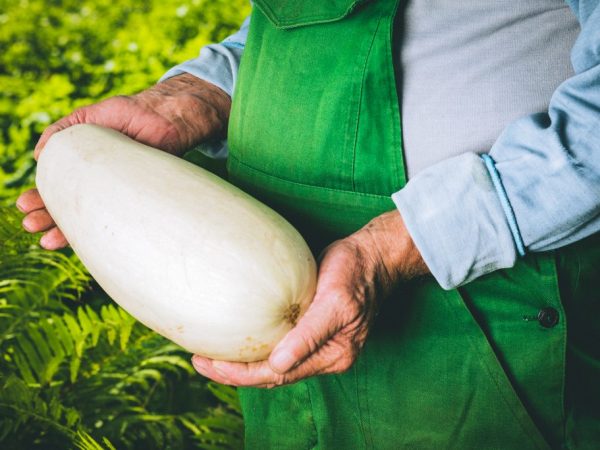
Varieties of white zucchini and the rules for their cultivation
The best varieties
A peculiarity of the species is unpretentiousness in care. It is suitable for gardeners who visit the site only once every few days.
Usually the seeds are harvested from previous harvests, but today this is not necessary - there are a wide variety of varieties of this vegetable on the market.
White-fruited
High-yielding and early maturing. Planted after potatoes or tomatoes. Shrub, not too curly. For 1 sq. m fits 2 pcs. Considered powdery mildew resistant.
Fruit:
- weight - up to 350 g;
- length - up to 20 cm;
- color is light green, pale green;
- give good taste on neutral soil after nightshade crops.
Aral
It is pollinated by insects, so open ground is preferable for it. Ripens in 45 days. High-yielding: one bush gives 15-20 kg of product. Resistant to powdery mildew, watermelon mosaic.
Fruit:
- length - 15-17 cm;
- weight - 250-400 g;
- whitish color;
- the peel is smooth.
Itself
Early ripe, period 35-40 days. It tolerates temperature drops, short-term drought. Pollinated by insects, but can also be grown in a greenhouse. Gives more yield in the second turn. About 15-16 kg are harvested from one bush. Resistant to viruses, mosaics.
Fruit:
- 18-20 cm;
- up to 500 g;
- soft fibers and pleasant taste.
Gribovsky 37
Average ripeness is from 40 to 60 days. Bred for temperate climates, therefore it successfully tolerates low temperatures. Sprawling bush with thorns on the stems. Fights fungus and bacteria well.
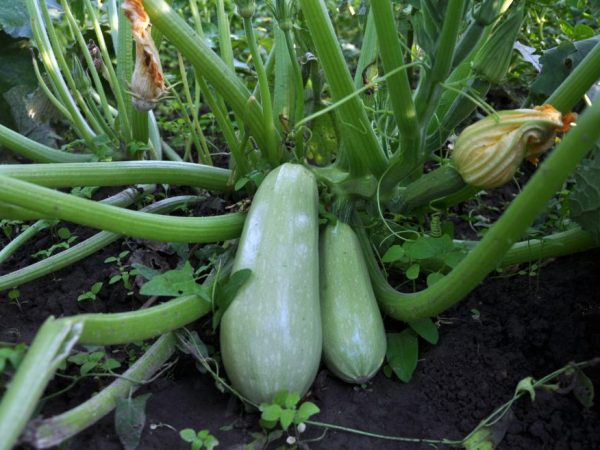
The plant successfully tolerates lower temperatures
Fruit:
- cylindrical smooth;
- 17-22 cm;
- 800-1200 g;
- white or light green.
Belogor
Early maturing, ripening period - 40-45 days. Bred for unprotected soil. Shrub, but compact: when planting, a gap of 65 cm is made. Fruiting up to 3 months.
Fruit:
- from 15 to 22 cm;
- 700-1000 g;
- the peel is white, thin;
- the pulp is suitable for preservation.
Chaklun
From early maturing varieties, ripening takes 40-45 days. Harvest amicable. Powdery mildew resistant, suitable for temperate climates.
Fruit:
- cylindrical;
- 15-18 cm;
- 300-400 g;
- thin but firm skin;
- firm and tender pulp.
The variety is stored for a long time and with high quality, but maximum 60 days. Overripe zucchini thickens at the base, the taste deteriorates.
Mountain
Universal, recommended for growing in Siberia, the Caucasus.
The ripening period depends on the weather, but on average it is 35-50 days. The bush branches poorly, compact. High safety during transportation.
Fruit:
- cylindrical, almost equal in thickness at the base and end;
- light green color;
- 600-800 g;
- up to 20 cm.
Tolerates low temperatures, low humidity. Resistant to fungi. View for industrial cultivation.
Hare's ear
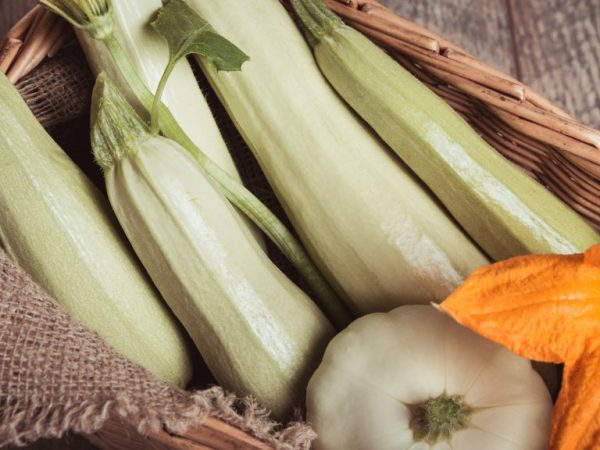
Zucchini Hare's ear are unpretentious in care
The white squash of this variety gets its name from its characteristic appearance.
They do not tolerate acidic soil, bear fruit poorly. The bushes are spreading, powerful. The variety is unpretentious, withstands short temperature drops and drought.
Fruit:
- long and thin;
- removed before reaching 20 cm;
- the pulp is elastic.
An overripe vegetable becomes cottony and tasteless. The hare's eye is suitable for all types of processing: stewing, frying, conservation.
Roller
Unpretentious variety. Bears fruit stably and amicably even in adverse conditions. It is well transported, stored for up to 2.5 months. The video ripens in 38 days. It has compact bushes with short shoots.
Fruit:
- up to 22 cm;
- about 800 g;
- the peel is soft;
- the pulp is fibrous and juicy.
The roller is suitable for temperate climates, resistant to some fungal and bacterial pathogens.
33 heroes
Mid-season, ripening - 50-57 days. Bears fruit for a month and a half. Disease resistant. The fruits are large, reaching 1.3 kg. Long, thick, cylindrical in shape. The recently appeared variety is still being tested in vegetable gardens. It is declared as universal, suitable for all types of processing, lies for a long time.
Iskander
Dutch hybrid suitable for temperate climates. Vegetation lasts 47 days. Forms ovaries even in weather below 20 ° C. The bushes are small, the main stem is up to 20 cm.
Fruit:
- 18-20 cm;
- 400-500 g;
- light thin peel;
- creamy pulp.
When overripe, it does not lose its taste. Harvest about 20 kg from one bush. The hybrid is resistant to peronosporosis and anthracnose.
Little boy
Early ripening, ripening takes 36-38 days after germination. Bears fruit amicably. A bush with short lashes. Resistant to powdery mildew, withstands a short cold snap. Used in home cooking and canning.
Fruit:
- 3-5 pcs. on a bush;
- weight - from 600 to 1800 g;
- cylindrical shape;
- the pulp contains a lot of sugar.
White Swan
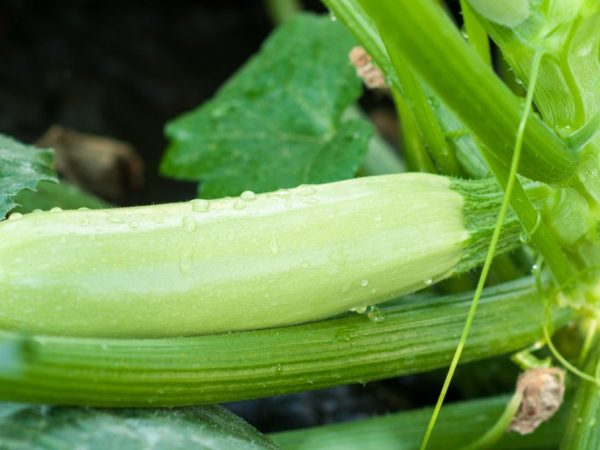
The variety is suitable for dietetic food
An early ripe zucchini variety, ripens up to 50 days. Has a high resistance to diseases, suitable for moderate streaks.
The acidic soil does not suit him, it bears fruit abundantly after potatoes, onions, tomatoes. Sowing is carried out in open ground after the end of the frost.
The white swan is characterized by the following signs:
- small size, smooth soft skin;
- weight - from 300 to 500 g;
- juicy pulp.
Contains a small amount of sugar, suitable for baby food and diabetics.
Spaghetti
The original hybrid. Suitable for southern regions or greenhouse cultivation. Matures from 3 to 4 months. Feature - the pulp when processed breaks down into fibers, it becomes similar to spaghetti.
Fruit:
- about 30 cm long;
- weight - 1.2-1.5 kg;
- the pulp is yellow;
- the rind is hard.
The bushes are powerful, vertical supports are installed for weaving.
Astronomer
Early ripe. Kustovoy, curls weakly. Disease resistant, high yielding.
Fruit:
- from 18 to 22 cm;
- 900-1200 g;
- slightly round in shape;
- light green skin;
- the pulp is white, contains a lot of iodine.
The astronomer is compact, suitable for climates with frequent temperature changes. Grown in greenhouses and open ground.
Polar bear
Early maturing, growing season - 36 days. Suitable for northern regions: it is stated that temperature drops do not affect fruiting. Resistant to decay.
Description of fruits:
- even shape;
- solid color;
- the skin is soft and white;
- the weight can be up to 1.3 kg.
According to reviews, the Polar Bear is on average 7 days late in ripening, overripe fruits deteriorate quickly, so they will have to be removed regularly. Suitable for all types of processing.
Gherkin
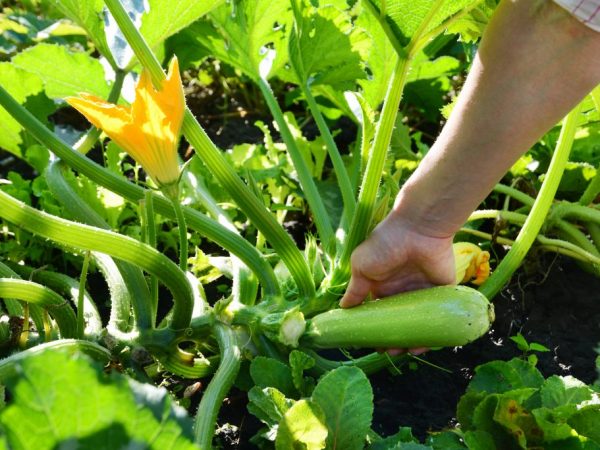
Fruits can be eaten fresh
Early ripening. Harvest on the 45th day. Bush variety, cold-resistant.
Mature zucchini have the following characteristics:
- 120-300 g;
- cylindrical, short, sometimes round;
- the pulp is dense, dryish.
Gherkin white-fruited zucchini is suitable for fresh consumption, for preservation as a whole. The pulp tastes like cucumbers.
Seed preparation for sowing
The material in packages from the originators is often sold already processed and calcined, so they are immediately planted in the soil. There are 2 ways to do this: dry planting and seedlings.
The first is suitable for regions with a warm and stable climate, and the second is suitable for the north and temperate latitudes, where the sprout is exposed to sudden temperature changes.
Also, the material is harvested from the obtained fruits in order to obtain the maximum indicators of size, taste and yield. Seeds are processed before planting in several stages:
- disinfection;
- etching;
- hardening;
- pecking.
The procedures increase the yield, such plants are less susceptible to fungal diseases, and they grow powerful. Most of the varieties are compact, because bushes vegetate longer. Therefore, the formation of white-fruited zucchini is almost unnecessary.
Calibration and disinfection
The prepared material is placed in a 1% salt solution. Floated seeds are unsuitable for planting because they are empty. The rest are washed and disinfected. Place them for 6 hours in hot water - 45-50 ° C.
After cooling down, add a new portion. Rinse in cold water for 2-3 minutes. If the gardener is confident in the quality of the planting material, then the following processing steps can be skipped.
Etching
Special solutions are prepared, in which the material is kept for 10-16 hours at room temperature. These are drugs for fungal infections:
- alirin-B;
- phytosporin-M.
The procedure reduces the risk of diseases of young shoots, and also forms the plant's resistance in the future. This is a necessary step, given the short growing season of the crop.
Hardening
This method prepares the seeds for changing weather. During the day they are left at room temperature and placed in the cold overnight. This is done for 3-4 days. Also prepare solutions of biostimulants - in them the seeds are soaked for better germination.
Another way is to put it in the refrigerator for a day, and then leave it in the sun for a week. The processed material is stored for no more than 24 hours - it is immediately planted in the substrate, otherwise it will dry out.
Pecking for seedlings
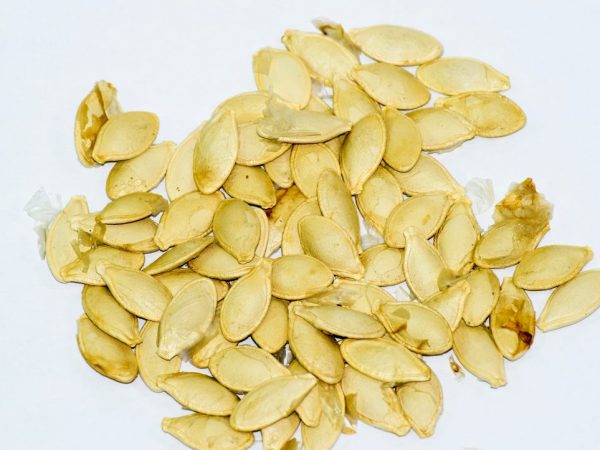
It is advisable to germinate the seeds before planting.
Some gardeners, before stimulation, put the seeds in a damp bag in the oven at 50-60 ° C or leave them in this form near the battery for 30 days. The fabric needs to be dampened. The material will start to sprout (at least 5 mm), then it can be planted in the soil.
Seedlings are prepared in early April. Pots are suitable for this. The recommended container volume is 0.5 liters. You can make seedlings at home in this way:
- prepare the soil in a ratio of 1: 3: 5: 0.5. This is leafy earth, humus, peat, sawdust;
- place the substrate in a pot, loosen it;
- bury a seed with a sprout of 1-3 cm;
- water.
Seedlings will appear in 3-5 days. The room is kept at a temperature of 20-23 ° C, the seedlings are watered, and they provide access to natural light or lamps. They must be planted in the garden after 1-1.5 months, when the plant has leaves.
A week before planting in the ground, they are taken out to the balcony or greenhouse so that the plant adapts to the natural temperature. Usually placed in the ground in late May - early June. The preparation will increase the chances of survival of the bushes, so the yield will be large.
Landing in dry ground
The same manipulations are carried out as for seedlings. Only seeds are introduced directly into the soil, when there is no longer frost and the temperature outside is above 10 ° C. It is important to choose the right place and prepare the ground.
Location
It is better to choose a place in the sun, blown out, but without a draft. The substrate is raised above ground level by 20-25 cm with the help of humus, compost and peat chips.At this place, the culture is grown for 3 years. You cannot plant seeds:
- after pumpkin and other types of zucchini;
- next to ornamental plants;
- next to the zucchini.
Zucchini bears fruit well after cabbage, potatoes, tomatoes, onions and legumes.
Garden bed preparation
They dig it up in the fall. Neutralize soil acid by adding fertilizers and minerals. Pour boiling water, manganese solution or some other disinfectant. Cover with a film or bag and leave until spring.
2 weeks before planting, the soil is loosened and fertilized with these means:
- rotted manure;
- superphosphate;
- potassium sulfate;
- wood ash.
Sand or rotted sawdust is added to soil with a large amount of clay.
Landing technology
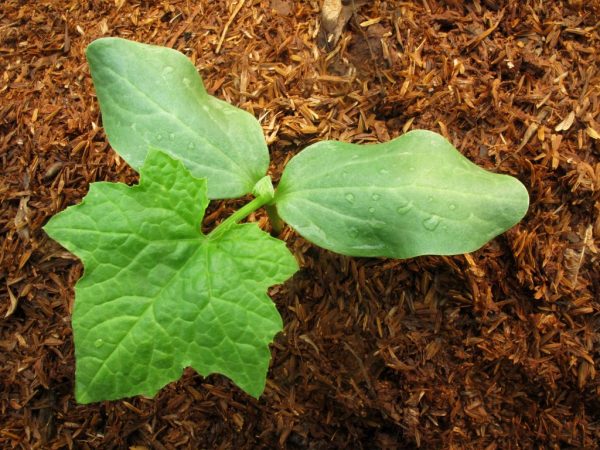
Young plants are fed with nitrogen fertilizers
Between the pits, they leave from 70 to 90 cm, the distance between the rows is from 80 to 100 cm. Per 1 sq. m there are 2-3 bushes. 2 seeds are placed in each hole. If both sprout, then remove the weak sprout so that it does not interfere with the strong one.
You need to deepen it by 3-4 cm, in loose soil - by 5-6 cm.If you bury the seeds too much, then the culture will not sprout. And the location near the surface will lead to freezing or drying out.
The sprouts are covered with plastic or foil to create a greenhouse effect. Young shoots are fed with nitrogen-containing fertilizers. Agrotechnical preparations for seedlings are suitable.
Growing
Crop care is standard. It grows quickly and efficiently, so few procedures are carried out. The advantage of zucchini is that they can be loosened and watered only once a week. Sometimes the formation of a bush is required.
Watering mode
If the month is dry, then the garden bed is watered once every 7 days, in the greenhouse - every 10 days. The norm is 5 liters of warm water per bush. After the first harvest - 10 liters. Excess leads to the development of fungal diseases and decay.
Do not water the crop 7 days before harvest.
The liquid is served at the root. After that, the soil is always loosened. Without regular weeding, a crust will form on the surface.
Pollination
White zucchini varieties have female and male flowers. In the first, the leg is thickened. Insects pollinate the crop on the site. They are attracted by spraying with syrup or diluted honey.
In the greenhouse, pollination is sometimes carried out independently, picking the male flower and bringing it to the female one. The door can be left open for insects to fly in.
Fertilizer
During the growing season, fertilize 2 times:
- when there are 4-5 leaves - about 12 days after planting;
- 7 days after.
Humus, compost, wood ash, infusion of nettle and dandelion leaves, chemicals are suitable for the culture. The latter are not used during fruiting. Superphosphate is used with an admixture of potassium nitrate. Chlorine-containing fertilizing is not recommended.
Harvesting and storage
White varieties are harvested upon reaching technical maturity. The main landmarks are the length and weight of the fetus. Gherkins are ready at 120 g, others - from 300 g with a length of 20 cm. You can also check ripeness by tapping on the fruit: a dull sound means ripeness. Hard skin is also an indicator.
It is preferable to pick vegetables every 3-4 days, otherwise they will overripe and new ovaries will not form. Cut the zucchini with a sharp knife, leaving a stalk 4-6 cm long.
For storage, they are washed, dried, and the leaves are removed. The harvest is sorted out, the rotten and damaged are used immediately. Others are left in a cool, dark place, lining it with straw. Cellars and basements are not used - it is too humid there.
Under the right conditions, fruit storage is 2-2.5 months. For harvesting for the winter, late-ripening varieties are chosen for the northern and temperate climates.
Gardeners reviews
White zucchini varieties are predominantly early and mid-season, therefore they are grown in all regions. Many gardeners speak positively about the subspecies of culture. They are easy to grow, store and care for.
Some varieties do not meet the declared parameters.Optimal species for cold climates: Gherkin, White Bear, Malchugan, Rolik, Sama, Aral. They have an ideal growing season and the fruit is universal for all types of processing.
For harvesting for the winter, only ripe fruits are harvested, placed in a cool, dark place. Gardeners say that the culture lies for about 2-2.5 months. without deterioration.
To get a good harvest promised by the manufacturer, they follow the rules of cultivation when preparing planting material and soil, fertilizing, forming, watering.

